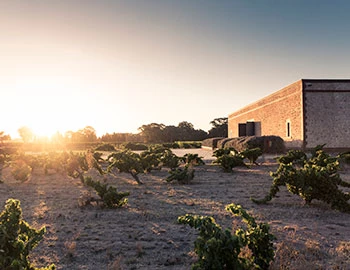Domaine Cornulus
What started out from humble beginnings over 20 years ago is now one of Valais’ flagship wineries and the byword for both a way of working in harmony with nature and premium wines, all of which strongly bring out their individual terroir.
Valais natives and cousins Stéphane Reynard and Dany Varone are perfectionists who love what they do. They tend to their vines, which live and thrive above Sion in the village of Savièse, as if they were their own children. Thanks to Dany Varone’s meticulous and expert work in the wine cellar, they craft terroir wines of the highest quality. This winemaking duo – now part of the Valais elite – laid the foundation for their successful Domaine Cornulus project in 1986, setting up the “Buteo” wine cellar and launching their “Garage Winery”. They bought their first harvests straight off the vines of various Savièse winegrowers and started pressing them in a garage. The following year, they leased their first vines in the vineyards above Sion (less than 1 hectare). In 1989 they created the Sélection Cornulus, after which their winery is named. A few harvests later, they acquired their first plots in the Clos de Mangold in 1995. Their dream of establishing a real domaine of their own gradually took shape. “After all, you will rarely find a good wine without terroir,” say Stéphane and Dany. In 1999 there followed the “prime cut”, the famous Clos des Corbassières, the jewel in the domaine’s crown. In the course of the “noughties”, they successively acquired various Grand Cru plots between Sion and Sierre as well as Clos Chamaray, St-Charles and La Follie. The rich palette of exquisite vines was finally rounded off to perfection by the magnificent Clos des Monzuettes.
White wines from Domaine Cornulus
Red wines from Domaine Cornulus
Today they cultivate almost 15 hectares (about 220 individual plots on steep terraces) with well over 20 grape varieties (including Petite Arvine, Johannisberg, Marsanne Blanche, Heida, Humagne Blanche, Syrah, Cornalin and Gamay), mostly according to biodynamic principles. Their aim is to use biodynamics to maintain the highest possible degree of terroir authenticity and grape typicity. Through their natural philosophy and working methods, they rebalance the relationship between plant, root and soil, while taking into account natural rhythms and cosmic influences.
At Cornulus, each vineyard is vinified separately so that the uniqueness of the terroir can fully unfold and give expression to its own authenticity; this is because the winemaking duo believes that an assemblage can never express the particularity of its valuable individual layers. They love the special features of the different soils that give each “terroir wine” its personality. In their wine ranges, Stéphane and Dany interpret different styles and philosophies. They keep the yields low, age the wines for longer on the yeast and, in some cases, dispense with malolactic fermentation. The expressive and storable crus are crafted from the grapes of the two premium sites Clos Mangold and Clos des Corbassières. The former lies between Sion and Sierre and is characterised by a terroir with a high gypsum content. The Clos des Corbassières is located on a steep and exposed terraced slope to the west of Sion.
The wines are for the most part produced in amphorae and barriques and stored under ideal conditions in a disused mine below the vineyard.
Producer

Standish / Dan Standish
The Standish Wine company was founded in 1999 by Dan Standish. He started at that time with a small, family-owned plot of almost hundred-year-old Shiraz vines in the heart of the Barossa Valley, in the sub-region of Vine Vale. He is part of the sixth generation of immigrants who settled here in 1848. In his career, Dan Standish gained experience not only in his home country, but also in California, Spain and France. He is passionate about the great wines of the Rhône Valley.

Rosa Bosco
Rosa Bosco, already somewhat of a legend in the oenological world of Friuli, founded her label “RB” in 1998. Her wines are vinified and aged in the de Puppi family’s traditional azienda according to the credo "quality without compromise”.

Château Biac
Sometimes life is full of surprises. The Lebanese Asseily family experienced this first-hand when they became the owners of Château Biac as if by accident in 2006. They regularly spent their summer holidays near Biac, but never would they have dreamt that they would own and manage this wonderful property themselves one day. It’s a fascinating story that Tony and Youmna Asseily are happy to share over a glass of their wine.













